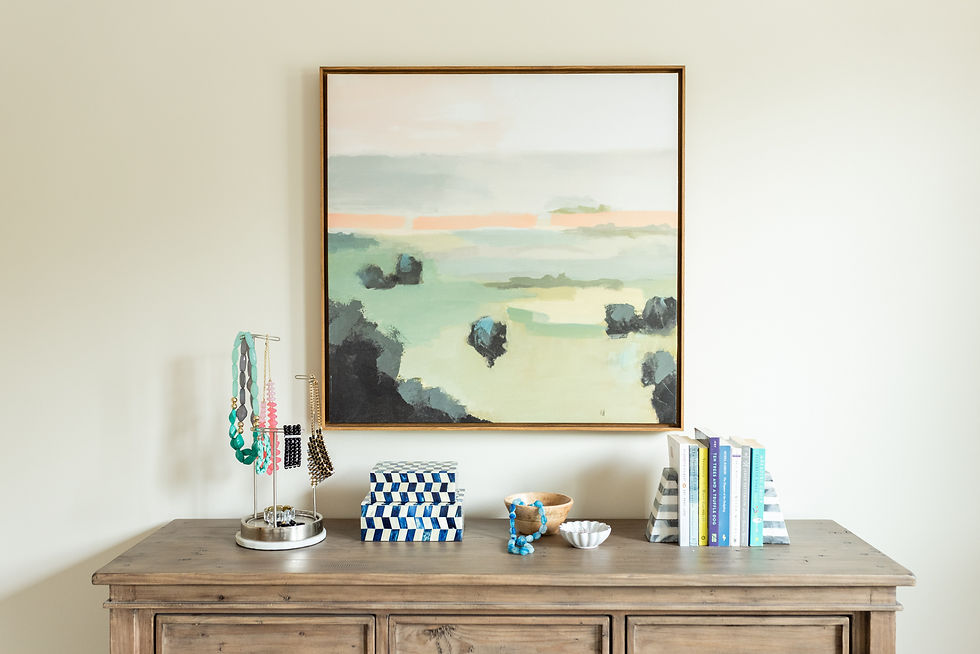How to Hang Artwork in Senior Living Communities
- Gregory Perrine

- Jun 28, 2019
- 4 min read
Updated: Aug 25, 2021

If there is one thing I have argued over my entire career, it has been how to hang artwork in senior living communities. I have gone into communities to see artwork hung too high, too low, crookedly, and in awkward groupings. Artwork is such an important part of a space, especially in senior living. It helps tie the colors of the room together. It gives residents and staff something to discuss. It helps warm up spaces and makes a community home. Below are some tips to help you hang your artwork in an aesthetically pleasing and efficient way.
Height
The industry-standard height for hanging artwork is to have the center of the piece at 58-60 inches. This is considered ‘eye level’. Our tall friends may not agree that this is eye level, but the majority of us fall into the 58-60″ range. Especially in areas like corridors, it is important that all of your artwork have the same center height to look cohesive. There may be situations where you have a taller piece of furniture, higher chair rail, or decorative molding where you are hanging. In these cases, you can push the center point measurement to the higher end of the spectrum, or even up to a couple of inches higher. Just make sure all pieces in the room or space have that same center point height. Personally, I hang all of my art at 60″. It seems to be high enough to clear furniture and is a good height going down corridors.
Grouping
As far as groupings, there are about a million ways to create groupings. In corridors, I will install groups of three, one on one side of the hall and a pair on the other directly across. The two pieces in the pair are always the same dimensions. I once had an art company disagree and say that having two different sizes next to each other would create movement down the corridor. I disagreed, saying that it looked like I messed up and ordered one piece the wrong size. The third piece does not have to be the same size as the pair but should be somewhat close in scale. When pulling together any grouping, keep in mind that the pieces should be tied together by some visual element-whether it be the frame, subject matter, or color scheme. You can also arrange grids like the set of four above or collage layouts, but you will treat the whole grouping as one piece and keep the center point of the grouping at your 58″-60″ mark.
Spacing
Spacing between groupings is extremely important. Depending on the size of the art, I will allow between 4″ and 12″ between pieces. The larger the pieces and space they are in, the more space you can have between them. For example: if you have two 48″W x 36″H pieces in a large dining room with 12′ ceilings, you can allow closer to 12″ in between the two pieces. Hanging pieces too far apart makes them look lost on the wall space, rather than working together to take up the space of a large piece.
Hanging
There are several ways to hang art. If you are buying art from a retail location, your hanging hardware is decided for you. Working through a framer or artwork company, you can choose which hanging hardware you would like used on your art. Below are the main types of hardware:
Wire hung or single bracket: These two types of hardware are most common when purchasing from retail locations. I advise against both of these because your staff will spend most of their days straightening artwork hung with a single point of weight distribution. These types are typically fine in residential locations, but commercially the amount of interaction makes these a maintenance nightmare. Depending on the frame, you may be able to have a framer add different hardware to modify these pieces.
Double D-Rings: This is another hardware often used in retail, and for medium to larger pieces. Having two weight distribution points helps keep these pieces from needing to be straightened. Be advised that on mass-produced pieces, the two rings may not be at the same height on the art. Keep this in mind when measuring for hanging and make sure to measure both sides. I have had rings be as far as an inch off from each other.
Security Hardware: Most communities and commercial spaces have their artwork hung with security hardware. This is to keep residents from pulling the art off of the wall (especially in memory care) and to prevent theft. Personally, I love it because having 3-4 security mounts stabilizes the art on the wall and keeps it from going crooked after being bumped. Hanging artwork with security hardware is not difficult, but it is a bit trickier than wire hung or D-Rings.

Hopefully, these tips will help with your artwork arranging and hanging. Also, check out the Tools and Resources section of our website for some hanging hardware and tools!



Comments